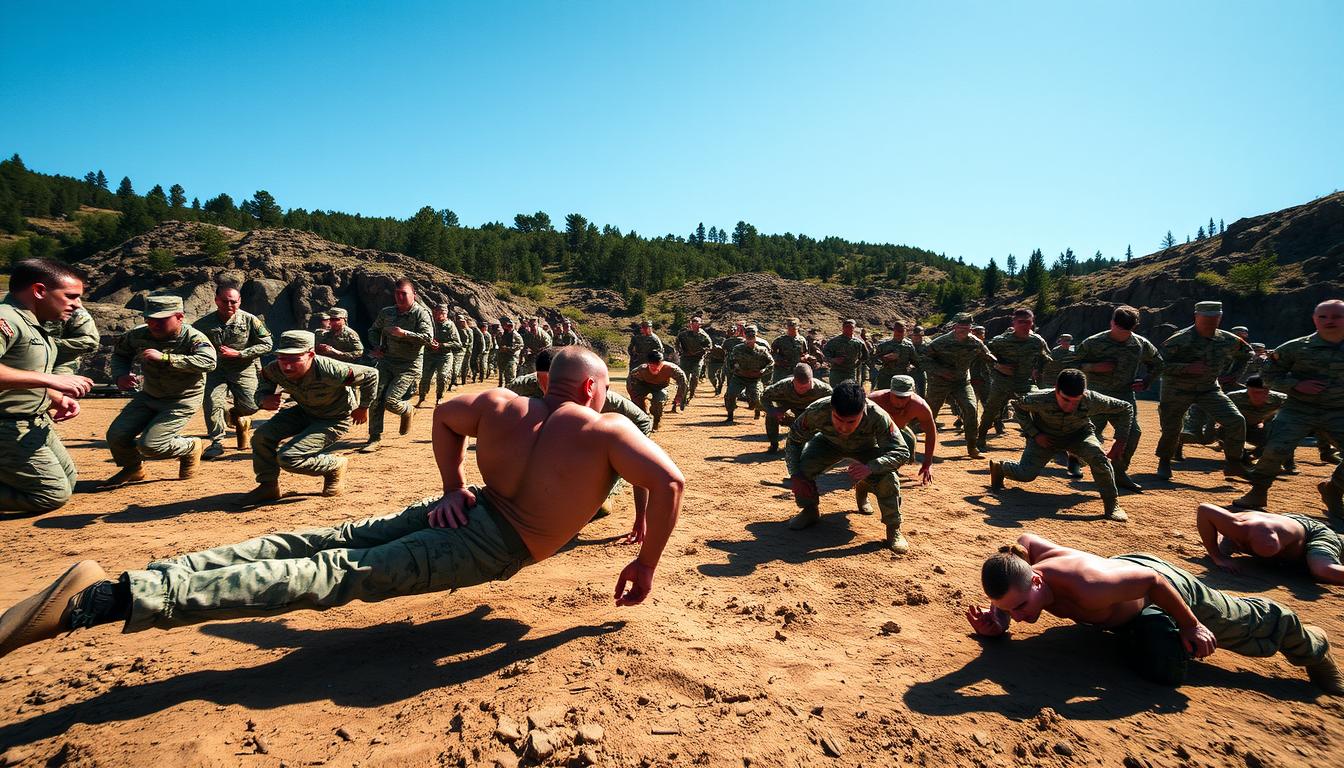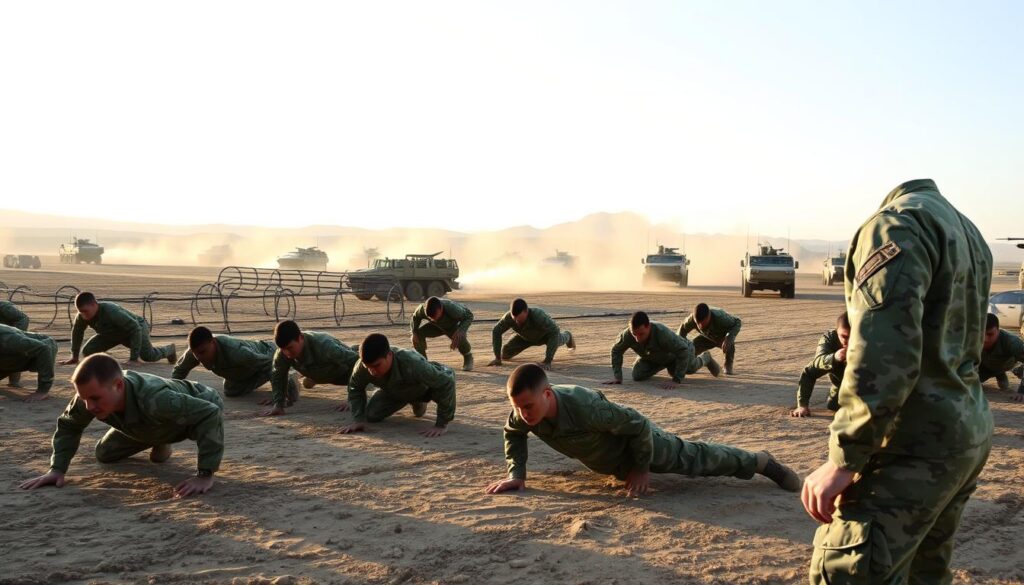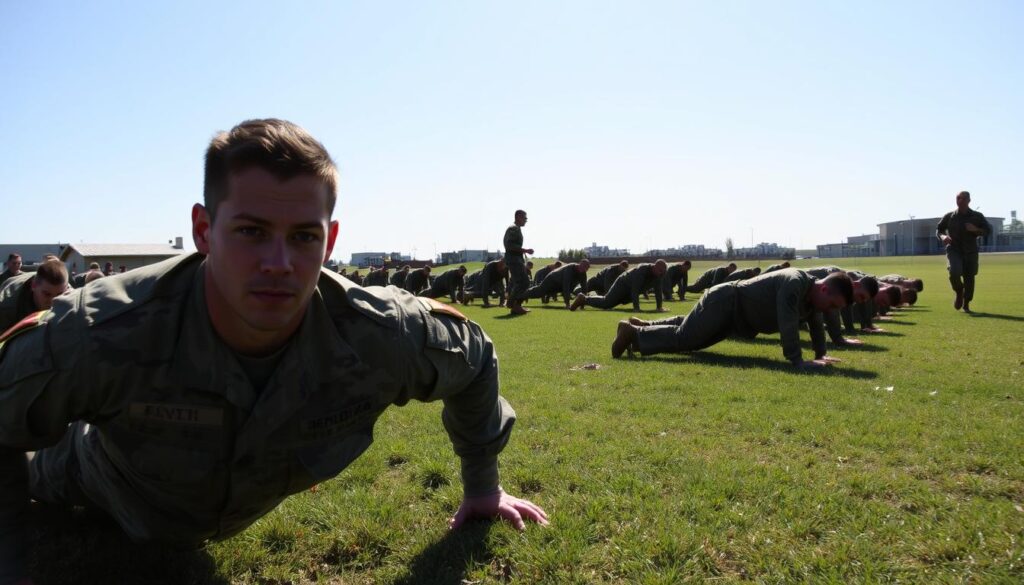Are you ready to start a journey that will test your limits and make you a strong soldier? The military fitness routine is tough. It builds your strength, endurance, and mental strength.
If you’re getting ready for military life, you need a beginner soldier workout schedule. This tough program has cardio, strength training, and flexibility exercises. It makes sure you’re ready for anything.
By sticking to a Army basic training workout plan, you’ll get much fitter. This will help you do well in Basic Training.
Key Takeaways
- Understand the components of a military fitness routine.
- Learn how to create a beginner soldier workout schedule.
- Discover the benefits of a structured workout plan.
- Improve your overall fitness and endurance.
- Increase your chances of success in Basic Training.
Overview of Army Basic Training
Army Basic Training is a key step for those joining the Army. It’s a tough program that turns people into skilled soldiers. They face many physical and mental tests.
The training has several phases, like Yellow, Red, White, and Blue. Each phase has its own challenges and exercises. People learn to get fitter and mentally stronger for military life.
What to Expect in Basic Training
Basic Training is very demanding. It includes a lot of activities to test your limits. You’ll learn new skills, discipline, and teamwork.
- Drills and ceremonies to instill discipline and teamwork
- Physical training to improve fitness and endurance
- Classroom instruction on military protocols and procedures
Importance of Physical Fitness
Being fit is key in Army Basic Training. Good fitness helps you pass the training and do your job well. The training includes cardiovascular exercises, strength training, and flexibility drills.
“The physical training program in Army Basic Training is designed to push individuals to their limits, preparing them for the demands of military life.”
Components of the Fitness Program
The fitness program in Army Basic Training covers many areas:
| Component | Description | Example Exercises |
|---|---|---|
| Cardiovascular Training | Improves heart health and endurance | Running, swimming, cycling |
| Strength Training | Builds muscle and increases strength | Weightlifting, push-ups, sit-ups |
| Flexibility and Mobility | Enhances flexibility and range of motion | Stretching exercises, yoga |
Key Exercises in the Army Workout Plan
To succeed in Basic Training, it’s key to know the main exercises in the Army workout plan. The Army Basic Training exercise routine boosts fitness, getting recruits ready for military life.
Cardiovascular Training
Cardiovascular training is a big part of the infantry fitness plan. Running, jogging, and other aerobic activities boost endurance and stamina. For example, recruits must run a set distance in a certain time, testing their heart health.
A military training expert says, “Cardiovascular endurance is key for daily tasks and Basic Training’s physical demands.” Preparing for Bootcamp is vital, and cardio training is a big part of it.
Strength Training Essentials
Strength training is also crucial in the military PT session. Push-ups, sit-ups, and weight training build muscle strength and endurance. These exercises are key for facing physical challenges.
- Push-ups: Strengthens the upper body and boosts upper body endurance.
- Sit-ups: Increases core strength and stability.
- Weight Training: Builds muscular strength and endurance.
Flexibility and Mobility Drills
Flexibility and mobility drills are also key in the Army workout plan. Stretching and yoga improve flexibility and range of motion, lowering injury risk during training.
Flexibility is often overlooked but is vital for peak physical performance. Adding stretching to your routine can greatly improve fitness and readiness for Basic Training.
“The right preparation is key to success in Basic Training. A well-rounded fitness routine that includes cardiovascular training, strength training, and flexibility exercises is essential.”
Weekly Workout Schedule
To succeed in Army Basic Training, having a weekly workout schedule is key. It should cover cardiovascular, strength, and flexibility exercises. This ensures recruits are ready for the training’s demands.
Sample Weekly Plan
A sample weekly workout schedule might look like this:
| Day | Morning Workout | Afternoon/Evening |
|---|---|---|
| Monday | Cardiovascular Training (Running, 30 minutes) | Strength Training (Push-ups, Pull-ups, Squats) |
| Tuesday | Strength Training (Upper Body) | Flexibility and Mobility Drills |
| Wednesday | Rest Day or Active Recovery (Light Jogging, Yoga) | Core Strengthening Exercises |
| Thursday | Cardiovascular Training (Swimming, Cycling) | Strength Training (Lower Body) |
| Friday | Strength Training (Upper Body) | Flexibility and Mobility Drills |
| Saturday | Rest Day or Active Recovery | Long, Slow Cardio Session (e.g., 1-hour run) |
| Sunday | Rest Day or Light Activity (e.g., stretching, short walk) | Review and Plan for the Upcoming Week |
Adjusting Intensity for Beginners
For beginners, start with a manageable intensity and gradually increase it. Start with shorter runs and fewer strength training reps. Begin with simple flexibility drills and increase the intensity as fitness improves. Learn more about adjusting your workout.
Tips for Staying Consistent
Consistency is key to achieving fitness goals. To stay on track, recruits should:
- Set realistic goals and track progress.
- Find a workout buddy or accountability partner.
- Mix up the routine to avoid boredom and prevent plateaus.
- Listen to their body and rest when needed to avoid injury.
By following a structured weekly workout schedule and staying committed, individuals can optimize their preparation for Army Basic Training and achieve their fitness goals.
Nutrition for Optimal Performance
Nutrition is key for military training. A balanced diet helps with energy, recovery, and health.
Fueling the Body
Eat lots of lean proteins, complex carbohydrates, and healthy fats. Lean proteins like chicken and fish help muscles heal. Complex carbs, like whole grains, give you energy that lasts.
Healthy fats in nuts and avocados are important for vitamin absorption and energy. A good meal could be grilled chicken, brown rice, and steamed veggies.
Recommended Meals and Snacks
Choose nutrient-dense foods for your meals. Here are some good options:
- Oatmeal with fruit and nuts for breakfast
- Grilled chicken with quinoa and veggies for lunch
- Lean beef with sweet potatoes and green beans for dinner
Snacks like fruits, energy bars, and trail mix keep your energy up between meals.
Hydration Guidelines
Drinking enough water is vital for performance and recovery. Aim for 8-10 glasses of water a day. Adjust based on how hard you’re training and the weather.
Check your urine color to see if you’re drinking enough. It should be pale yellow. Electrolyte-rich drinks are good for hard workouts.
Preparing for Basic Training Success
Success in Army Basic Training needs physical fitness, mental toughness, and good planning. The Army’s Basic Training overview shows it’s tough. It tests your endurance, strength, and how you bounce back.
Mental Preparation and Resilience
Mental readiness is as key as being fit. Having a positive outlook, imagining success, and setting goals helps. It keeps you motivated and on track.
Setting Realistic Fitness Goals
It’s important to set goals you can reach in the workout plan. Work on your heart health, get stronger, and be more flexible.
Resources for Further Training
Looking for more help? There are online workout plans and fitness coaches. They offer tips on mental prep and more training resources.



